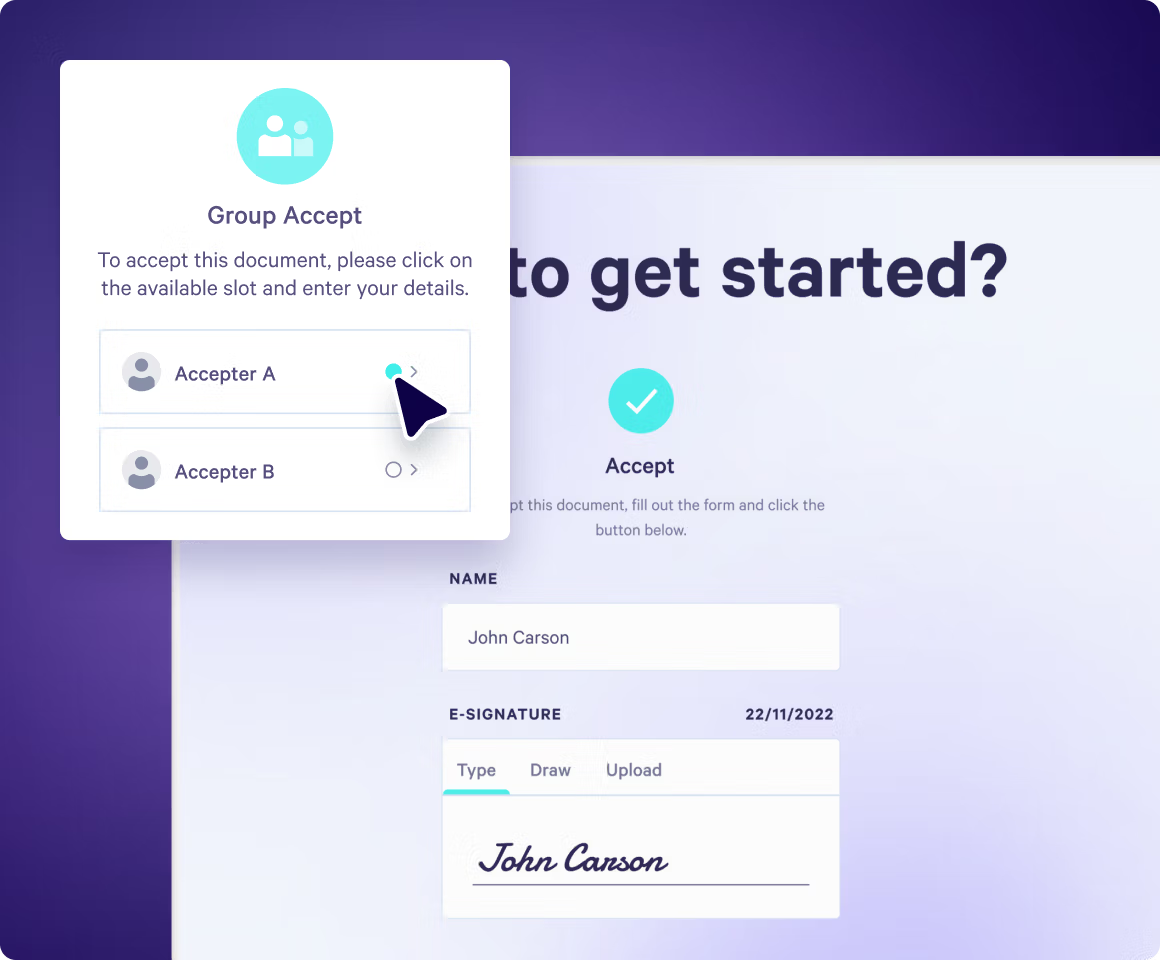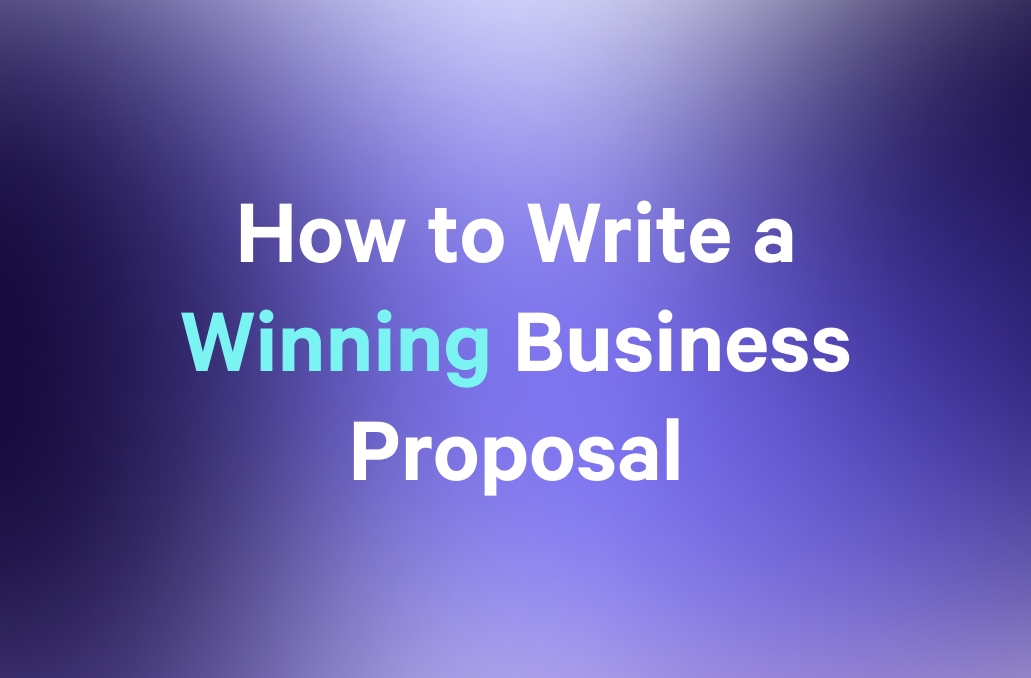Writing a conference proposal can feel overwhelming. First, you have to pack your big ideas, research, or discoveries into a few words; then these words have to appeal to the attention of conference organizers over a host of other applicants.
So, there's no pressure there, then…
In this article, we'll look at formulating the perfect conference proposal. Above all, we'll focus on making an impact. Writing a business proposal isn't just about listing what you know. It's also about explaining how your work will make a difference, break new ground, or introduce new ideas to conference attendees.
We've put together all the essential steps and even included a conference proposal template to remove the confusion from this process, help you find your unique angle, and make your proposal jump out of the pile.
Key takeaways
- Crafting a conference proposal requires understanding the event's theme and tailoring your content to align with it.
- A compelling title and strong abstract are crucial to grab attention and express the core of your work.
- Clearly outlining objectives and presentation content helps to convey the value of your presentation.
- Detailing your methodology and highlighting the significance of your work demonstrates your expertise and the impact of your research.
- Concluding with expected outcomes and offering additional materials can enhance the overall presentation and invite further discussion.
What is a conference proposal?
A conference proposal is a formal outline for conference planners that provides a detailed preview of a presentation or workshop you'd like to give at their event. The aim is to secure a place by demonstrating the value of your presentation to the conference attendees.
It's a compact, enticing preview of the innovative ideas or groundbreaking research you want to present. Your goal is to connect your work and message to the big picture and show that it's new, meaningful, and impactful.
The challenge is to present all of this in just a few hundred words. Writing a good conference proposal demonstrates your subject matter expertise in a way that is engaging and understandable to a broader audience.
Steps to write your conference proposal: Key elements to include
The best conference proposals have an element of story-telling, exciting the conference organizers and proposal reviewers about the content of your presentation and the value it will provide to its guests. With some guidance and our expert tips, you have all the key elements for a successful proposal.
1. Understand the conference theme
To write a successful conference proposal, it's essential to understand the event's purpose and theme clearly. Research both the conference and its attendees. It's ‘Writing101: Know Your Audience’! This will help you tailor your proposal to perfectly align with the event's goals, making it more likely to be accepted by both the organizers and the audience. Understand what is being discussed and where your contribution enriches the conversation.
2. Choose a compelling title
Your title should be eye-catching, memorable, and hint at what will come. This step is crucial because your title is the first thing that introduces your work to the conference organizers and participants.
The title should work like a headline for your talk or research report. It needs to be clear enough for people to understand your presentation and interesting enough for them to want to know more.
Your title should hint at your point of view or particular approach to the conference topic. You don't have to give everything away in the title, but it should give a little taste of what participants can expect from your presentation.
3. Write a strong abstract
This is where you express the core of your work in a few gripping paragraphs. Start by clearly formulating the problem or question your research tackles. You must also explain why this problem is important, interesting, or new. Your first few sentences are crucial for hooking the interest here.
Then, describe them how you solved the problem. Show off your expertise, but steer clear of complicated industry jargon. Describe your methods or approach in simple terms that anyone can understand. You should also highlight the key insights or solutions you found and emphasize why they're essential.
Conclude your abstract by talking about the larger implications of your work. Here, you can connect your discoveries to the larger field and show how your research makes a difference.
4. Outline your objectives
This part shows the exciting things you'll share in your presentation. When you formulate your goals, you tell your audience: "This is what you'll learn or see." At the beginning, think about what you want the audience to take away from your presentation. This could be a new idea, a different perspective on a problem, or even a new skill. Think carefully about these goals because they'll determine what you talk about and how you design your presentation.
Being clear and concise about your objectives means choosing what you think is most important and what you want people to know about. It's about choosing the parts of your work that will bring the most value. You don't have to cover every single point of your topic. Instead, focus on the parts that will most benefit your audience.
5. Detail your presentation outline and content
First, you tell people about the main ideas and questions you'll talk about. It is your chance to get them interested in the exciting questions you'll answer or the information you share.
Next, you get to the heart of your talk. This is the middle part, where you back up the main points with evidence, examples, or stories from your work. Make sure each point connects to the next, creating a narrative that makes your audience see things in a different light.
Think about how you can make your presentation interactive. Are you planning a Q&A session, panel discussion, live polls, or hands-on activities? This will turn the audience into active participants and your presentation into a conversation rather than a monologue.
6. Describe your methodology
Here, you can look behind the scenes and show how you created your project. Talk about the steps, tools, and strategies you used to turn your ideas into reality.
Start by explaining how you approached your main question or challenge. This may mean telling how you planned your research, what information you gathered, or what theories guided you. Aim to make everything clear enough for someone not in your field to understand, too.
Then, you go into the details of your methods. If you conducted experiments, talk about how you set them up and what you tested. If your work is more about theory, share how you interacted with existing ideas or developed new ideas.
It's also important to explain why you chose a particular approach. Why was this method the best choice for your question? How does it make your results more reliable? This shows the diligent work behind all of your choices.
7. Highlight the significance
Start by talking about the significant impact of your work. Ask yourself what your research tells us about your field, a particular problem, or the world in general. While it's important to state facts, you should also try to present your research as a crucial piece of a larger puzzle. Whether challenging old ideas or introducing a new solution, ensure people understand its value.
8. Conclude with expected outcomes
While discussing outcomes, circle back to the goals you mentioned initially. Now that you have presented your plan circle back to the goals from the start and link these to the expected results. Show that your presentation is more than just a list of exciting ideas — it's another vital step on this path.
Be bold when stating the expected changes and the impact of your solid and relevant work.
Talk about how these results will advance the discussion in your field. By outlining what you expect after your presentation, you invite others to take your ideas further and contribute their own.
9. Offer additional materials
Consider what else you can add to your presentation to make it unique. For example, you can provide toolkits or research papers for people who want to know more about the subject. But, choose carefully and make sure it genuinely enhances your presentation.
Next, explain how you'll distribute these materials. Will you distribute printed materials or direct people to a website or online space where they can find everything? The main goal is to make it easy for your audience to use these resources. By adding additional materials to your proposal, you show conference organizers you bring a rich, comprehensive experience to the table.
Check out our video on how to create winning business proposals backed by real data:
Conference proposal template
In addition to using these elements, a conference proposal template can also be a great help.
Qwilr's Conference Proposal Template is designed to walk you through the whole process, making it easier to share your ideas in a clear, engaging, and confident way.
Here is what our template includes:
- Title of the Proposal: This is your headline, the first impression determining whether people want to dive deeper. Make it enjoyable and clear so people get excited about what you will talk about.
- Presenter Information: Here's where you introduce yourself. Tell people the story of who you are, where you come from, and your background.
- Abstract: The abstract is your quick pitch. In a few short sentences, sum up the main points of your talk, including what question you're answering, how you went about it, and what people will take away from it. You need to be clear, while simultaneously sparking interest..
- Objectives: Clearly state what you hope to accomplish with your talk. It could be to share new information, spark a discussion, or showcase your latest findings.
- Content Outline: This is where you lay out the plan for your allotted period. List the main points you'll cover, previewing the journey you're taking your audience on. This shows you've got plenty to share and that it will be interesting and relevant.
- Methodology: Talk about how you did your work. Whether it was through peer review and research, analysis, or case studies, this part shows the hard work and thought you put into your project.
- Significance: Here, explain why your work matters. How does it add to the greater story of your field? This part makes your proposal go from informative to really impactful.
- Conclusion: Finish by reviewing the main points again and what you hope will come out of your presentation. Leave your audience with a final thought that's both reflective and forward-thinking.
- Additional Materials: Offer extra resources that go with your presentation. These extras enrich your audience's experience and extend your talk's impact, whether it's more detailed papers, data, or tools.
Top tips for creating conference proposals
You know what you need to include and you’ve got the template—here are some expert tips on how to make your conference proposal stand out.
Focus on clarity over complexity
Use clear and concise language that simplifies without dumbing down. This means avoiding overly technical language or academic jargon while remaining professional and knowledgeable. Use active verbs and concise phrasing–if you can say it in 5 words instead of 10, do so.
Tell a story
The best way to engage prospects and evoke emotive reactions is to structure your proposal like a mini-story. Do this by hooking your audience at the start with a thought-provoking question or a statement that sparks curiosity. Then, take them through the challenge, opportunity, approach, and impact within the context of the story.
Highlight originality and distinction
What makes your proposal unique? To stand out among the many submissions, you need to articulate what sets you apart from the competition.
Explain how your session presents fresh ideas and approaches, share unique angles derived from your experience to showcase your expertise, and clearly define how your conference fills a gap or builds upon prior content.
Include a call-to-action element
Adding a subtle call to action in your proposal can leave a strong impression. It shows you’re focused on engaging with prospects and delivering results. With Qwilr you can embed a Calendly calendar for prospects to book a follow-up meeting or provide an opportunity for them to accept the proposal on the spot with the e-signature function.

Create better proposals with Qwilr
To write a successful conference proposal, you must be clear, make your work appealing, and emphasize its importance.
Between these essential tips and the Qwilr Conference Proposal Template, you have all you need for a proposal that gets you conference bookings and ensures bums on seats when you get there! Want to try it for yourself? Snag a 14-day free trial and get started immediately.
About the author

Brendan Connaughton|Head of Growth Marketing
Brendan heads up growth marketing and demand generation at Qwilr, overseeing performance marketing, SEO, and lifecycle initiatives. Brendan has been instrumental in developing go-to-market functions for a number of high-growth startups and challenger brands.
Frequently asked questions
The ideal format for a conference proposal submission is clear, well-organized, and attention-grabbing. It should clearly show your goals, how you intend to achieve them, why your work matters, and what you hope to gain from it.
While you can submit similar proposals to different conferences, this is usually not recommended. You should tailor each proposal to the specific topic and audience of the conference you are applying to.
Including a few key references can strengthen your proposal by situating your work within the broader academic conversation. However, be selective and focus on works that directly support the significance and methodology of your work.


